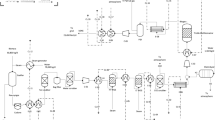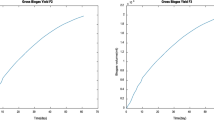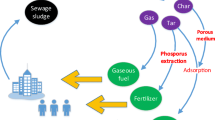Abstract
Biomass frequently constrains its widespread application due to its low economic efficiency. In this project, a new approach of biomass application was explored to reduce bio-syngas production cost. A model for the bio-syngas production from biomass gasification and bio-syngas purification (Selexol and water scrubbing) were studied. Based on the simulation results, we assessed the feasibility and viability of the project. Preliminary results showed that the bio-syngas production cost with Selexol (2.15 $/Nm3) is even higher than biomass used in power generation systems (equal to 1.58–2.21 $/Nm3). However, water scrubber was used as bio-syngas purification, the capital investment cost and bio-syngas production cost (1.34 $/Nm3) was significantly reduced. A sensitivity analysis was conducted on the bio-syngas price, which could be further reduced by various factors: biomass price, carbon taxes, and carbon credits. We assumed that bio-syngas was applied to natural gas pipeline, our analysis showed that the application of bio-syngas (2 to 10% content) to natural gas had little impact on natural gas properties: combustion value and price. The technology of water scrubber makes the applications of biomass-based fuels competitive.









Similar content being viewed by others
Data availability
The datasets used and/or analyzed during the current study are available from the corresponding author on reasonable request.
References
AlZubi AA et al (2023) Synthesis of porous, hydrophobic aerogel through the reinforcement of bamboo-shaped oxidized multi-walled carbon nanotubes in the silica matrix for oil spill cleaning. Clean Technol Environ Policy 25(6):1–13
Dmitrienko MA, Nyashina GS, Strizhak PA (2018) Major gas emissions from combustion of slurry fuels based on coal, coal waste, and coal derivatives. J Clean Prod 177:284–301
Taba LE et al (2012) The effect of temperature on various parameters in coal, biomass and CO-gasification: a review. Renew Sustain Energy Rev 16(8):5584–5596
Ekwurzel B et al (2017) The rise in global atmospheric CO2, surface temperature, and sea level from emissions traced to major carbon producers. Clim Change 144(4):579–590
Leal-Arcas R, Carafa L (2014) Road to Paris COP21: towards soft global governance for climate change. Renew Energy L & Pol’y Rev 5:130
Tawn R, Browell J (2022) A review of very short-term wind and solar power forecasting. Renew Sust Energ Rev 153:111758
Yang F, Meerman J, Faaij A (2021) Carbon capture and biomass in industry: a techno-economic analysis and comparison of negative emission options. Renew Sustain Energy Rev 144:111028
Braimakis K et al (2020) Εnergy-exergy analysis of ultra-supercritical biomass-fuelled steam power plants for industrial CHP, district heating and cooling. Renew Energy 154:252–269
Abdul Malek A, Hasanuzzaman M, Rahim NA (2020) Prospects, progress, challenges and policies for clean power generation from biomass resources. Clean Technol Environ Policy 22:1229–1253
Fushimi C (2021) Valorization of biomass power generation system: noble use of combustion and integration with energy storage. Energy Fuels 35(5):3715–3730
Lu X et al (2019) Gasification of coal and biomass as a net carbon-negative power source for environment-friendly electricity generation in China. Proc Natl Acad Sci 116(17):8206–8213
Couto N et al (2013) Influence of the biomass gasification processes on the final composition of syngas. Energy Proc 36:596–606
Giuliano A, Catizzone E, Freda C (2021) Process simulation and environmental aspects of dimethyl ether production from digestate-derived syngas. Int J Environ Res Public Health 18(2):807
Sookramoon K (2018) Syngas from Updraft Gasifier Incineration for Internal Combustion Engine Power Generation in Klongluang PathumThani Thailand[C]//MATEC Web of Conferences. EDP Sciences 187:03002
Abdoulmoumine N et al (2015) A review on biomass gasification syngas cleanup. Appl Energy 155:294–307
Voldsund M, Jordal K, Anantharaman R (2016) Hydrogen production with CO2 capture. Int J Hydrogen Energy 41(9):4969–4992
Zang G et al (2018) A comparative study of biomass integrated gasification combined cycle power systems: performance analysis. Biores Technol 255:246–256
Ashkanani HE et al (2020) Levelized cost of CO2 captured using five physical solvents in pre-combustion applications. Int J Greenhouse Gas Control 101:103135
Ou H-W, Chou M-S, Chang H-Y (2020) Removal of hydrogen sulfide from biogas using a bubbling tank fed with aerated wastewater. Aerosol Air Qual Res 20(3):643–653
Li Z et al (2019) Optimization of a wet scrubber with electrolyzed water spray—Part I: Ammonia removal. J Air Waste Manag Assoc 69(5):592–602
Lee B-K et al (2013) Evaluating the performance of a turbulent wet scrubber for scrubbing particulate matter. J Air Waste Manag Assoc 63(5):499–506
Vargas-Moreno J et al (2012) A review of the mathematical models for predicting the heating value of biomass materials. Renew Sustain Energy Rev 16(5):3065–3083
Serrano C, Portero H, Monedero E (2013) Pine chips combustion in a 50 kW domestic biomass boiler. Fuel 111:564–573
Kombe EY et al (2022) Numerical investigation of sugarcane bagasse gasification using Aspen Plus and response surface methodology. Energy Convers Manage 254:115198
Lee C-J et al (2009) Optimal gas-to-liquid product selection from natural gas under uncertain price scenarios. Ind Eng Chem Res 48(2):794–800
Gambarotta A, Morini M, Zubani A (2018) A non-stoichiometric equilibrium model for the simulation of the biomass gasification process. Appl Energy 227:119–127
Puig-Gamero M et al (2018) Three integrated process simulation using aspen plus®: Pine gasification, syngas cleaning and methanol synthesis. Energy Convers Manage 177:416–427
Ahmad MI et al (2015) Performance and carbon efficiency analysis of biomass via stratified gasifier. ARPN J Eng Appl Sci 10(20):9533–9537
Agrawal R et al (2007) Sustainable fuel for the transportation sector. Proc Natl Acad Sci USA 104(12):4828–4833
Chen Z-S, Wang L-Q (2013) Energy and exergy analysis of gas production from biomass intermittent gasification. J Renew Sustain Energy 5(6):063141
Khzouz M, Gkanas EI (2017) Experimental and numerical study of low temperature methane steam reforming for hydrogen production. Catalysts 8(1):5
Kohl AL and Nielsen RB 1997 Physical solvents for acid gas removal. Gas Purif: 5
Frilund C et al (2021) Small-to medium-scale deep syngas purification: biomass-to-liquids multi-contaminant removal demonstration. Biomass Bioenerg 148:106031
Craig K R, Mann M K (1996) Cost and performance analysis of biomass-based integrated gasification combined-cycle (BIGCC) power systems[R]. National Renewable Energy Lab.(NREL), Golden, CO (United States)
Addai-Asante S, Hao T (2017) Techno-economic analysis of biomass integrated electricity generation system. Nat Gas 200:5–49
Kreutz TG et al (2020) Techno-economic prospects for producing Fischer-Tropsch jet fuel and electricity from lignite and woody biomass with CO2 capture for EOR. Appl Energy 279:115841
Li X et al (2021) Multi-criteria decision making of biomass gasification-based cogeneration systems with heat storage and solid dehumidification of desiccant coated heat exchangers. Energy 233:121122
Rubin ES, Davison JE, Herzog HJ (2015) The cost of CO2 capture and storage. Int J Greenhouse Gas Control 40:378–400
Toweh J (2020) Evaluating the Effectiveness of Scrubber Installation on Sulfur Dioxide Emissions from Coal Electricity Generating Units[D] 1–22
Susanto H, Suria T, Pranolo S (2018) Economic analysis of biomass gasification for generating electricity in rural areas in Indonesia. In IOP Conference Series: Materials Science and Engineering. IOP Publishing
IEA-ETSAP I (2015) Biomass for Heat and Power[J]. Technology Brief, IEA-ETSAP and IRENA© Technology Brief E05 e January 1–24
Zhang Z et al (2021) Simulation and techno-economic assessment of bio-methanol production from pine biomass, biochar and pyrolysis oil. Sustain Energy Technol Assess 44:101002
Patrizio P et al (2021) CO2 mitigation or removal: the optimal uses of biomass in energy system decarbonization. Iscience 24(7):102765
Mohamed U et al (2020) Sustainability evaluation of biomass direct gasification using chemical looping technology for power generation with and w/o CO2 capture. Energy 205:117904
Kim H, Parajuli P B, Yu F, et al (2011) Economic analysis and assessment of syngas production using a modeling approach[C]//2011 Louisville, Kentucky, August 7-10, 2011. American Society of Agricultural and Biological Engineers 1
Migo-Sumagang MVP et al (2020) Rice-straw-based heat generation system compared to open-field burning and soil incorporation of rice straw: an assessment of energy, GHG emissions, and economic impacts. Sustainability 12(13):5327
Gielen D (2012) Renewable energy technologies: cost analysis series. Sol photovolt 1(1):52
Masum MFH. Projecting the sustainability of biopower generation in Georgia, United States. 2020, University of Georgia.
Pomerleau K and Asen E. 2019 Carbon tax and revenue recycling: revenue, economic, and distributional implications. Fiscal Fact: 674
Antonanzas J, Quinn JC (2023) Regional greenhouse gas analysis of compressor drivers in natural gas transmission systems in Canada. J Clean Prod 400:136671
Moura IDP et al (2021) Carbon dioxide abatement by integration of methane bi-reforming process with ammonia and urea synthesis. Renew Sustain Energy Rev 151:111619
Acknowledgements
The authors are very grateful to express great appreciation to Pierre-Oliver Lemire and Jinsheng Xiao for his valuable and constructive suggestions in this study.
Author information
Authors and Affiliations
Contributions
Patrice Mangin proposed the conception of the whole paper and provided the resources needed for the paper. Benoit Delcroix provided the software and analyzed the software data. Olivier Rezazgui was responsible for the formal analysis and the review of the article. Zhihai Zhang validated the simulation results and completed the paper.
Corresponding author
Ethics declarations
Declarations
Ethics approval and consent to participate.
Not applicable.
Consent for publication
Not applicable.
Competing interests
The authors declare no competing interests.
Additional information
Publisher's Note
Springer Nature remains neutral with regard to jurisdictional claims in published maps and institutional affiliations.
Rights and permissions
Springer Nature or its licensor (e.g. a society or other partner) holds exclusive rights to this article under a publishing agreement with the author(s) or other rightsholder(s); author self-archiving of the accepted manuscript version of this article is solely governed by the terms of such publishing agreement and applicable law.
About this article
Cite this article
Zhang, Z., Rezazgui, O., Delcroix, B. et al. A comparison of the bio-syngas production costs from biomass using gas post-treatment of water scrubber and Selexol. Biomass Conv. Bioref. (2024). https://doi.org/10.1007/s13399-024-05369-9
Received:
Revised:
Accepted:
Published:
DOI: https://doi.org/10.1007/s13399-024-05369-9




